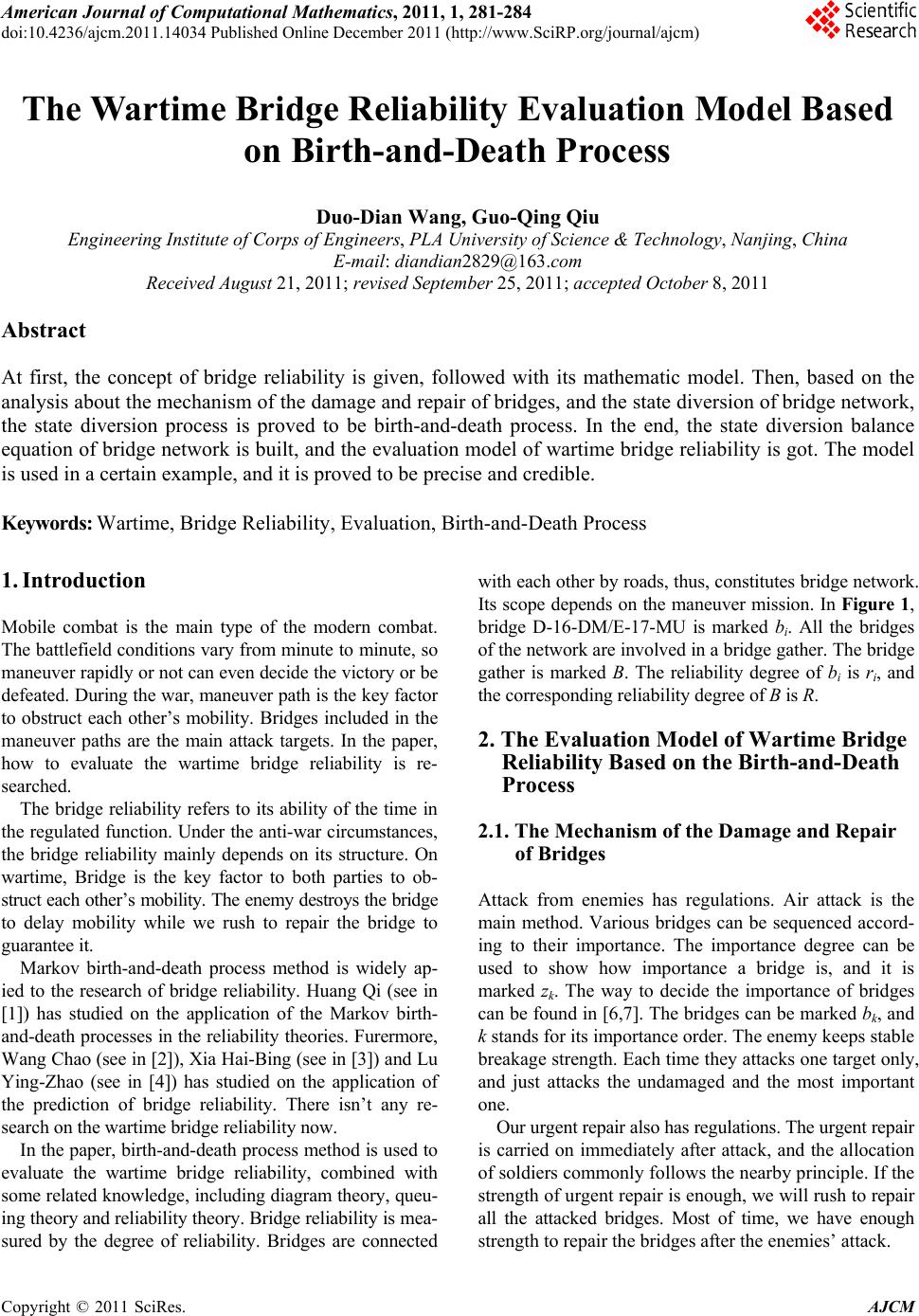
American Journal of Computational Mathematics, 2011, 1, 281-284
doi:10.4236/ajcm.2011.14034 Published Online December 2011 (http://www.SciRP.org/journal/ajcm)
Copyright © 2011 SciRes. AJCM
The Wartime Bridge Reliability Evaluation Model Based
on Birth-and-Death Process
Duo-Dian Wang, Guo-Qing Qiu
Engineering Institute of Corps of Engineers, PLA University of Science & Technology, Nanjing, China
E-mail: diandian2829@163.com
Received August 21, 2011; revised Septe mber 25, 2011; accepted October 8, 2011
Abstract
At first, the concept of bridge reliability is given, followed with its mathematic model. Then, based on the
analysis about the mechanism of the damage and repair of bridges, and the state diversion of bridge network,
the state diversion process is proved to be birth-and-death process. In the end, the state diversion balance
equation of bridge network is built, and the evaluation model of wartime bridge reliability is got. The model
is used in a certain example, and it is proved to be precise and credible.
Keywords: Wartime, Bridge Reliability, Evaluation, Birth-and-Death Process
1. Introduction
Mobile combat is the main type of the modern combat.
The battlefield conditions vary from minute to minute, so
maneuver rapidly or not can even decide the victory or be
defeated. During the war, maneuver path is the key factor
to obstruct each other’s mobility. Bridges included in the
maneuver paths are the main attack targets. In the paper,
how to evaluate the wartime bridge reliability is re-
searched.
The bridge reliability refers to its ability of the time in
the regulated function. Under the anti-war circumstances,
the bridge reliability mainly depends on its structure. On
wartime, Bridge is the key factor to both parties to ob-
struct each other’s mobility. The enemy destroys the bridge
to delay mobility while we rush to repair the bridge to
guarantee it.
Markov birth-and-death process method is widely ap-
ied to the research of bridge reliability. Huang Qi (see in
[1]) has studied on the application of the Markov birth-
and-death processes in the reliability theories. Furermore,
Wang Chao (see in [2]), Xia Hai-Bing (see in [3]) and Lu
Ying-Zhao (see in [4]) has studied on the application of
the prediction of bridge reliability. There isn’t any re-
search on the wartime bridge reliability now .
In the paper, birth-and-death process method is used to
evaluate the wartime bridge reliability, combined with
some related knowledge, including diagram theory, queu-
ing theory and reliabilit y theory. Brid g e reliabilit y is mea-
sured by the degree of reliability. Bridges are connected
with each other by roads, thus, constitutes bridge network.
Its scope depends on the maneuver mission. In Figure 1,
bridge D-16-DM/E-17-MU is marked bi. All the bridges
of the network are involved in a bridge gather. The bridge
gather is marked B. The reliability degree of bi is ri, and
the corresponding rel i a bili ty degree of B is R.
2. The Evaluation Model of Wartime Bridge
Reliability Based on the Birth-and-Death
Process
2.1. The Mechanism of the Damage and Repair
of Bridges
Attack from enemies has regulations. Air attack is the
main method. Various bridges can be sequenced accord-
ing to their importance. The importance degree can be
used to show how importance a bridge is, and it is
marked zk. The way to decide the importance of bridges
can be found in [6,7]. The bridges can be marked bk, and
k stands for its importance order. The enemy keeps stable
breakage strength . Each time they attacks one target only,
and just attacks the undamaged and the most important
one.
Our urgent repair also has regulations. The urgent repair
is carried on immediately after attack, and the allocation
of soldiers commonly follows the nearby principle. If the
strength of urgent repair is enough, we will rush to repair
all the attacked bridges. Most of time, we have enough
strength to repair the bridges after the enemies’ attack.